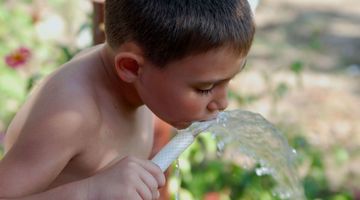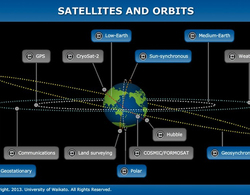

A satellite is anything that orbits around another object. Moons are natural satellites that orbit around planets, whereas artificial satellites are objects that people have made and launched ...
READ MORE

Observing and asking questions are essential parts of what a scientist does. Through their observations, scientists try to build more accurate explanations of how the world works. The scientists ...
READ MORE

Water seems to be everywhere in New Zealand. Oceans surround us. There are hundreds of lakes and rivers. Some South Island regions get more than 10 metres of rain each year. We have so much ...
READ MORE

In this activity, students learn about the surface tension of water by experimenting with bubbles. By the end of this activity, students should be able to: demonstrate the effect of soap on ...
READ MORE

If you live in a town or city, have you ever wondered where your drinking water comes from? Water is collected from a natural source, then has to go through a treatment process. Treating drinking ...
READ MORE

In this activity, students investigate the issues surrounding water in their local area and relate this knowledge to water issues in other countries. By the end of this activity, students should ...
READ MORE

When well managed, class discussion can help students examine, evaluate and share knowledge about a subject, providing opportunities for students to think critically and creatively, consider ...
READ MORE

In this unit, students will consider the performance properties of new stab and flame-resistant fabric and design protective wear for new market opportunities. Purpose To investigate the ...
READ MORE

Students develop their knowledge to design a disposable product as a sustainable alternative to an existing product. Purpose To consider the issues of increasing plastics use and understand why ...
READ MORE
Dr Allan McInnes and Dr Adrian McDonald, from the University of Canterbury, explain how gravity and projectile motion keep natural and artificial satellites in an orbital path.
READ MORE
NIWA scientist Dr Katja Riedel travels to Antarctica to collect 300-year-old ice samples. She studies the ice to learn how our atmosphere has changed over the centuries.
READ MORE
Scientists observe water in its different forms to develop explanations of how the world works.
READ MORE

The size, orbit and design of a satellite depend on its purpose. In this interactive, scientists discuss the functions of various satellites and orbits. Accompanying fact files provide ...
READ MORE

This interactive explores water as a solid, liquid and gas. The water molecules stay the same, but they behave differently as they change from one form to another. Click on the labels for more ...
READ MORE

Most urban drinking water is cleaned and treated in an ordered series of steps.
READ MORE